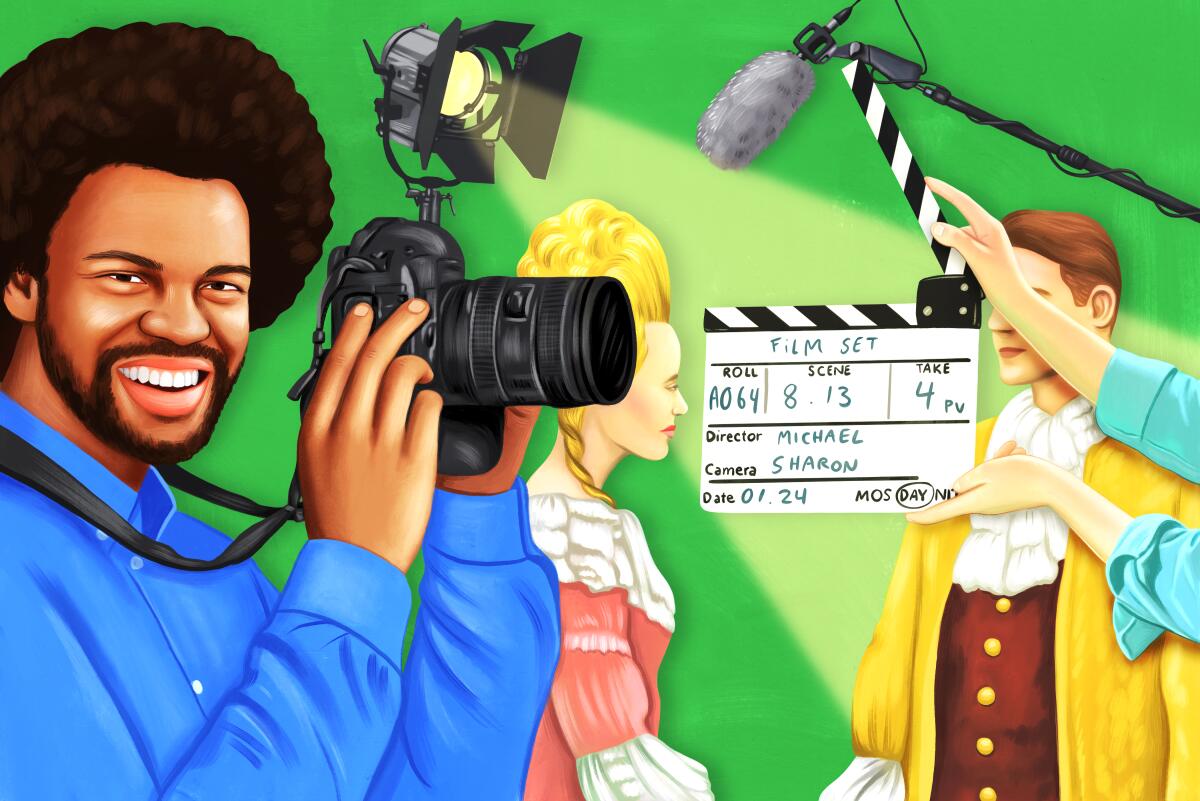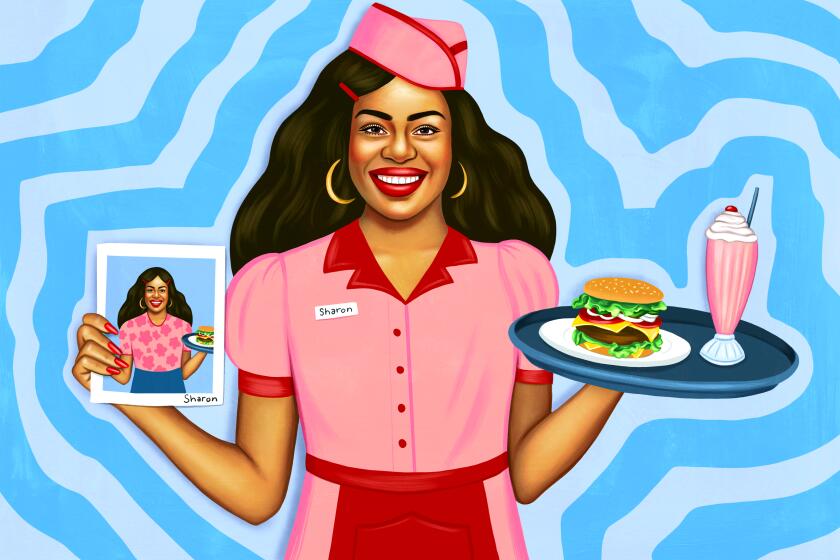Explaining Hollywood: How to become a unit photographer

- Share via
Every day, unit photographer Warrick Page said he jumps out of bed excited to watch — and photograph — cast members and crews creating movies and television series.
Page’s latest work involved photographing HBO’s new series “Winning Time: The Rise of the Lakers Dynasty,” a drama that chronicles the professional and personal lives of the 1980s Los Angeles Lakers.
One day, the production re-created Lakers center Kareem Abdul-Jabbar, who moonlighted as an actor, filming a scene from the 1980 comedy “Airplane!” Page said everyone on set could not stop laughing at one of the scene’s main jokes — a small child telling Abdul-Jabbar (played by Solomon Hughes) that he wasn’t trying hard enough on the court. And Page was front and center, snapping a photo of this hilarious confrontation.
His stills from that scene are on the show’s website. There are also photos of Quincy Isaiah, portraying Magic Johnson, holding up his No. 32 jersey while standing between John C. Reilly, as Jerry Buss, and Michael Boucher, playing Jack Curran.
Also known as on-set photographers or still photographers, unit photographers assist in telling the story of what a movie or television show is about. Their images are used in the press package for media outlets, on the production’s website, on billboards and in social media.
These photos (or “stills”) often offer glimpses from the film, but they can also offer a behind-the-scenes view of the production. For example, they could show the director huddling with an actor, actors laughing together in between takes or the director pointing at a position for the gaffer and crew.
The Times spoke with unit photographers Page, Michael Becker, Hopper Stone and Chara Andrews about their experiences on set. Here are their thoughts about how to get started and do well in the field.
In June, the L.A. Times launched a guide to entertainment industry careers. We explained some of the basics and answered your questions. Here’s some of what we’ve learned so far.
Who becomes a unit photographer?
Unit photographers often have a love for film, and they’re people who would enjoy working on a variety of different sets. It’s not uncommon for unit photographers to come from other types of photography.
Page, for example, was a photojournalist living in London and covering conflicts in areas like Iraq and Gaza when he decided in 2013 to start taking photos on film sets instead. He’d been thinking about making the switch for some time as a way to combine his loves of photography and film.
Page was inspired by photojournalist Karen Ballard’s successful move from news to working on the set of Steven Spielberg’s “Munich.” Ballard continues to photograph current events as well as film sets to this day.
It also helps to be a people person, Becker said, because you’re not on the set every day, and when you are, you’re doing something most actors don’t like: having their picture taken when they’re working.
It’s also helpful, Page said, if people at every level of the production feel you care about them and their process. “When you do that, the world tends to open up to you, and you’re going to get better pictures,” he said.
How do you get started?
Landing a job on a production set has a lot to do with your portfolio of work, Becker said. Becker has been the still photographer on a number of reality shows, including “American Idol,” “The Masked Singer” and “Master Chef Junior.”
He said an online portfolio must have great shots, but more important, it needs to show that you understand that a production’s publicist is looking for images that can be used for marketing.
You want to demonstrate that you can tell a story about the film and the people behind it. Having great behind-the-scenes shots shows that you can integrate with a cast and crew on set, he said.
For the record:
12:52 p.m. Feb. 15, 2022A previous version of the story said Hopper Stone suggested that a film-school degree wasn’t necessary, but couldn’t hurt as a starting point for a set photographer. He was referring to a degree in photography.
Stone, president of the Society of Motion Picture Still Photographers, said he doesn’t believe it’s absolutely necessary to have a degree in photography for this job, but it doesn’t hurt.
Rejection and uncertainty are part of working in Hollywood, but joy, creativity and fun can be too. Here’s how to manage your mental health.
Andrews, who recently moved to Los Angeles and has shot behind-the-scenes photos for several projects, earned a bachelor’s degree at UC Davis through the cinema and digital media program with an art studio minor. The program is a combined study of media and the methods of production.
Andrews said the program gave her photography education a pivotal foundation. It’s shown her not only how to make the best use of her digital camera, she said, but also how to find creative ways to capture the right angle to tell a story.
Nevertheless, Stone said, a lot of experience and knowledge you’ll need for the position you’ll learn on the job.
Andrews landed unit photography gigs by networking. She joined Women of Color Unite, an organization that focuses on fair access, treatment and pay for women of color in all aspects of the entertainment and media industries. It’s through these meetings that Andrews learned of upcoming projects that needed an on-set photographer.
What are the career paths?
Building experience in entertainment industry careers often means working on independent films or student projects for little to no pay before joining the relevant union. Gaining experience as a unit photographer is no different.
Becker and Stone worked on low-budget and independent projects that were nonunion jobs to build up their portfolios. They estimated that it can take anywhere from eight months to a year of sporadic gigs before gaining a steady stream of work.
Becker was previously a music producer — he wrote “In the Deep” for the film “Crash” — before he switched to working as a still photographer for reality television in the early 2000s.
At the time, reality television jobs weren’t covered by the union contract, he said. When those projects did come under the union umbrella, Becker was eligible to become a member of Local 600 of the International Cinematographers Guild and get listed on the motion picture industry’s roster of experienced professionals.
To apply for the roster, you need 100 days of documented work on nonunion sets or 30 days on union productions.
There’s a quicker way to get on that list, Becker said. If you jump on a nonunion project that later gains a union contract, the production can ask for you to stay on. If you have 30 days of nonunion work done by that point, then you’ll get to join the union and be put on the roster.
Stone said he knows unit photographers who have worked in the camera and lighting departments.
Andrews hopes to gain experience with her on-set photography and learn from the camera and lighting crews on sets to eventually become a cinematographer.
For many people who pursue entertainment as a career, it takes years to get yourself to where you are making money from your creative work. For making money in the meantime, there’s always waiting tables. But more and more people are turning to platforms like TikTok, Twitch and Patreon.
How do you make money?
In the first few years of your career, you might not get a steady stream of gigs, and sometimes you’ll work on projects for free.
Andrews’ main source of income comes from working at a camera rental house. She was advised to work there to learn more about the basics of a camera — and to be at the right place at the right time when other job opportunities arise. Andrews said production crews sometimes ask for extra help when they pick up their equipment, and she is ready to sign on.
She also does portrait photography to supplement her income. Side photography gigs are ways to make money in the meantime and still be adjacent to the entertainment industry. Stone said that at the beginnings of his unit photographer career, he worked for the New York-based photo agency Black Star.
Once you’ve joined the International Cinematographers Guild, you will be eligible for the hourly and weekly pay rates set by the union’s contracts. For example, the guild’s hourly rate in 2021 for a still photographer on a TV miniseries was $52 an hour or $1,800 a week. The rate for an hour-long TV series was $64 an hour.
Not all productions employ union crews, so when there’s no contract, you will have to negotiate your own rates as a freelancer. In those cases, Stone advised taking into account all the work you do and the time that it takes to do it. This includes your equipment, the time it takes on set to capture your shots, the time it takes to get back to your desk and choose the best shots, and the work it takes to edit your photos.
How is this career different than it was 10 or 25 years ago?
There are more opportunities for still photographers now, Stone said, because there’s so much more content being created. Before Netflix, Hulu, Paramount+ and a host of other online platforms emerged, there was a lot of competition for jobs on the four major television networks, he said.
Becker added that social media has changed the scope of what still photographers are required to capture on set. Once celebrities started sharing their own personal sneak peeks from inside the hair and makeup trailer, he said, people wanted more.
Whenever he gets an assignment, Becker said, there’s a lot of emphasis on behind-the-scenes shots.
Another big change is the shift from film to digital cameras. Stone said he used to shoot several rolls of film on a set and send them off to a photo lab for the photo editors to parse through — and pay for the development of the film.
Film cameras were also loud, so quieting a camera’s shutter on set was an issue. When Becker shot “Malcolm in the Middle” in the 2000s, he had to cover his camera with a sweater to mask the sound. At the time, Stone said, only one person made blimps (camera cases that reduce shutter and zoom noise) in the Los Angeles area, and the wait time for the product could be at least two months.
With digital cameras, you can take hundreds of photos in a matter of hours. But for a unit photographer, Stone said, this means having to spend more time parsing through and editing shots.
Actors who have chosen to pursue Hollywood later in life as a second career share their experiences and advice.
What advice do pros always hear that is wrong?
Page said you’ll often be told to persistently contact studios for a job. “Don’t ever contact a studio or a photo producer” — the person overseeing a shoot — “unless you have something to offer them,” he said. “They get a million people contacting them every day wanting work.”
After you land a new job on a production, everyone says you should be friendly on set, Page said. Although that’s right, he said, the best relationships you can make are with members of the grip crew.
The grips who are in charge of setting up camera equipment have a sense of where you can be during filming — how close you can get to your subjects to get your shot — because you’re essentially competing for space with the camera, sound, dolly and grip crews.
What’s some good advice?
Learn how to do your job while not getting in the way. Page and Becker say that understanding everyone’s role on the production is another way to understand what space you have to work with while staying out of everyone’s way. Otherwise, people can get frustrated with your presence.
Be mindful of the call sheet, Page said, and if there’s a specific scene you believe is worth capturing, talk with the photo editor about it. Otherwise, you’ll be given a list of specific scenes to capture and have limited opportunities to shoot other ones.
Create a community. Andrews said to never be afraid to network with people in the field. “I would not be doing what I’m doing had I not linked up with some of these groups that really inspire me and that gave me the confidence to move to L.A. and just go for it,” she said.
Ask for advice and pointers over coffee, Stone said. He never turns down a cup of coffee to talk with aspiring still photographers and look over their portfolios.
Know how your camera works. Stone said you need to know the mechanical ins and outs of your camera before you head onto a production set. The set is not the place to learn. You need to be ready to shoot.
This isn’t a side gig. Being a unit photographer is a difficult craft, Stone said, so you have to be all in. He explained that photographers interested in trying out this job have to be ready to invest in themselves, because it’s a lot of hard work.
Because there is a lot of responsibility that comes with getting the right shot, he said, it’s OK to be nervous.
“I’ll be honest. Every time I finish [an assignment] and I do a good job, I feel like I’ve gotten away with it,” he said. “So for all of your fellow sufferers of imposter syndrome out there, you are not alone.”
More to Read
Inside the business of entertainment
The Wide Shot brings you news, analysis and insights on everything from streaming wars to production — and what it all means for the future.
You may occasionally receive promotional content from the Los Angeles Times.















